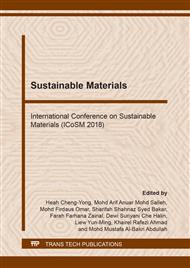[1]
M.A.A.M. Salleh, S. McDonald, and K. Nogita, Applied Mechanics and Materials. Vol. 421 (2013), pp.260-266.
Google Scholar
[2]
M.A.A.M. Salleh, M.H. Hazizi, Z.A. Ahmad, K. Hussin, and K.R. Ahmad, Advanced Materials Research. Vol. 277 (2011), pp.106-111.
Google Scholar
[3]
M.A.A.M. Salleh, C.M. Gourlay, J.W. Xian, S.A. Belyakov, H. Yasuda, S.D. McDonald, and K. Nogita, Scientific Reports. Vol. 7 (2017), p.40010.
Google Scholar
[4]
M.I.I. Ramli, M.A.A.M. Salleh, M.N. Derman, R.M. Said, N.M. Nasir, and N. Saud. Wettability and Shear Strength of Sn-Cu-Ni-xSi3N4 Composite Solder. in Key Engineering Materials. 2016. Trans Tech Publications.
DOI: 10.4028/www.scientific.net/kem.700.152
Google Scholar
[5]
M. Ramli, M.M. Salleh, M.A.B. Abdullah, R. Said, A. Sandu, and N. Saud. Microstructural and phase analysis of Sn-Cu-Ni-XSiC composite solder. in AIP Conference Proceedings. 2017. AIP Publishing.
DOI: 10.1063/1.4981848
Google Scholar
[6]
H. Wang, J. Fang, Z. Xu, and X. Zhang, J Mater Sci: Mater Electron. Vol. 26 (2015), pp.3589-3595.
Google Scholar
[7]
Y. Gao, J. Hui, X. Sun, F. Zhao, J. Zhao, C. Cheng, Z. Luo, and L. Wang, Procedia Engineering. Vol. 16 (2011), pp.807-811.
Google Scholar
[8]
H.R. Kotadia, A. Rahnama, A. Das, S. Sridhar, and S.H. Mannan, p.
Google Scholar
[9]
E. Siahaan, IOP Conference Series: Materials Science and Engineering. Vol. 237 (2017), p.012044.
Google Scholar
[10]
H.Y. Song, Q.S. Zhu, Z.G. Wang, J.K. Shang, and M. Lu, Materials Science and Engineering A. Vol. 527 (2010), pp.1343-1350.
Google Scholar
[11]
G. Zeng, S.D. McDonald, D. Mu, Y. Terada, H. Yasuda, Q. Gu, M.M. Salleh, and K. Nogita, Journal of Alloys and Compounds. Vol. 685 (2016), pp.471-482.
DOI: 10.1016/j.jallcom.2016.05.263
Google Scholar
[12]
G. Zeng, S.D. McDonald, Q. Gu, Y. Terada, K. Uesugi, H. Yasuda, and K. Nogita, Acta Materialia. Vol. 83 (2015), pp.357-371.
DOI: 10.1016/j.actamat.2014.10.003
Google Scholar
[13]
F. Wang, X. Ma, and Y. Qian, Scripta Materialia. Vol. 55 (2005), pp.699-702.
Google Scholar


